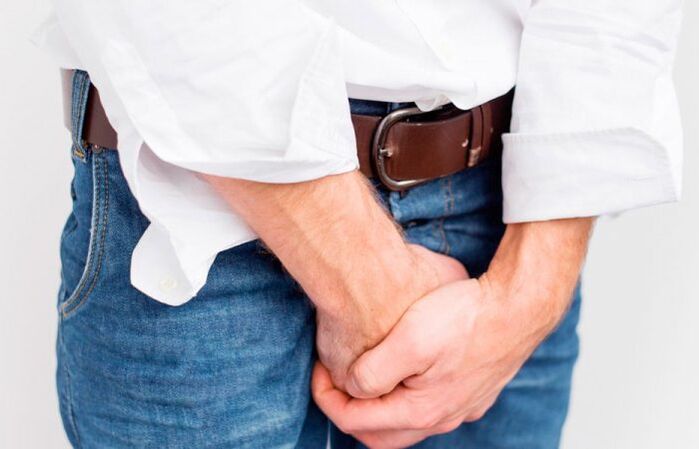Symptoms of prostatitis can be noticed a few days after the onset of the disease. Depending on age, the individual patient's condition, and other nuances, the disease may manifest clearly or progress more quietly. Early medical attention and prompt diagnosis guarantee successful treatment without complications and recurrence.

Risk group
Inflammation of the prostate is increasingly being diagnosed in men. The nature of the disease is simple. The glands are normally very small but can increase dramatically, compressing the urinary tract and seminiferous ducts, causing problems with urination and normal ejaculation. The disease occurs for many reasons. The following patients are at risk:
- middle-aged and elderly;
- overweight and obesity;
- smokers and alcoholics;
- People with urogenital diseases (urethritis, cystitis, orchitis, balanitis, balanoposthitis, pyelonephritis);
- irregular sex life;
- Practice interruption of sexual intercourse as the primary method of contraception;
- Are being treated with strong drugs (hormonal drugs, antibiotics).

Symptoms of the disease were observed in middle-aged and elderly patients decades ago. But today, the disease is increasingly common among young active men without any specific health problems. Urologists distinguish 4 types of prostatitis: acute and chronic infectious, non-bacterial, and prostatic pain.
The acute form of infection is more common in younger, sexually active men. The disease is caused by bacteria entering the urethra and ureter. The source of infection is usually the pathogen of sexually transmitted disease: Streptococcus, Neisseria gonorrhoeae, Treponema pallidum, Trichomonas, Chlamydia. In some cases, bacteria can enter the urethra from the rectum. This occurs when genital hygiene is inadequate. Without proper treatment, acute infectious prostatitis can become chronic. It is characterized by alternating breaks and sudden deterioration of health. As the disease progresses, episodes become more frequent and last longer.
Onset of the disease: how to identify it
The initial symptoms of prostatitis can easily be confused with the manifestations of other diseases. That's why patients don't rush to see a doctor and take painkillers or antipyretics on their own. One sign that should alert you is going to the toilet too often. The man began to notice a small amount of urine that was dark in color or almost clear. Gradually, the flow of urine becomes painful, the urethra feels itchy and burning, and the external genitalia become irritated and red.

Another typical manifestation is a persistent feeling of fullness in the bladder. The overgrown glands press against the ureter, and urine is secreted drop by drop or leaks spontaneously. Maybe nocturnal incontinence, where pus, pus, or mucus can drain from the urethra.
Sexual dysfunction was observed almost simultaneously. An enlarged prostate blocks the flow of testosterone, and men notice decreased libido, premature ejaculation, and worsening erections.
Against the background of inflammatory processes and failures in the genital area, it is possible that the patient becomes tense, irritable, aggressive outbursts or depressed, depressed mood.
Fatigue is common. An active person tires quickly and feels sleepy, but even long sleep doesn't bring happiness. Efficiency drops and the body is unable to fight infection. As a result, even the common cold can lead to complications that further worsen the patient's condition.
signs and manifestations

Symptoms of prostatitis in men can be overt or covert. It all depends on the individual characteristics of the body, the presence of other chronic diseases, age and other points. Usually the first characteristic manifestations appear within days or weeks after the onset of the disease. These include:
- repeated false urges to urinate;
- urethral pain during and after urination;
- Local edema of the genitals;
- Feeling that the bladder is not completely empty;
- Urine production problems;
- Dull pain in the lower abdomen;
- discomfort in the scrotum and lower back;
- general discomfort;
- short-term warming.
With prostatitis, patients may experience sleep and appetite problems, usually constipation, alternating with diarrhea. The main symptoms of prostatitis are features of non-bacterial forms that appear and disappear, become more pronounced or noticeably diminish. With chronic inflammation of the prostate, the characteristic signs are not felt for a long time.
They can be so lethargic that men don't show concern, attributing worsening health to colds, stress and work fatigue. According to statistics, almost a quarter of patients do not feel sick for a few months after the onset.

Acute infectious prostatitis, the symptoms of which become apparent after a few days, manifest as a sharp rise in temperature, burning and pain in the urethra, and a constant urge to go to the toilet. The patient will experience chills and fever. Possible bowel problems. During inflammation, tissue becomes loose and easily damaged. The patient delays going to the toilet, and the stool is compressed and barely passes through the rectum. In severe forms, the development of hemorrhoids, the appearance of rectal fissures and other unpleasant consequences are possible.
A prominent symptom of acute prostatitis is blood and pus in the urine. Urine becomes more cloudy and has an unpleasant odor. The urine flows out or stays in drop by drop for several hours, causing severe swelling. Everything is talking about an acute inflammatory process. At the first signs of prostatitis, it is advisable to contact a therapist who will refer to a urologist.
Prostate pain and its symptoms
Prostate pain is a non-inflammatory form of prostatitis. It occurs in 30% of middle-aged and older men. The disease develops in a latent or acute form with a spectrum of features of noninfectious prostatitis.
The main difference in this disease is the absence of hyperthermia, edema, suppuration. At the same time, the patient constantly experiences a distinct pain: pulling, aching, throbbing. It can be positioned in the perineum, extending into the lower back, legs, lower abdomen, scrotum, or penis. Pain occurs with rest or over exertion; pain medication blockade or strong medication can relieve the attack. Antibiotics don't help because the inflammatory component isn't present.
Prostate pain is characterized by problems with urination. in:
- slow flow;
- hourglass;
- incomplete emptying of the bladder;
- frequent wrong impulses;
- Difficulty urinating (complete absence of urine).
How to make a diagnosis

For prostatitis of any nature, the most important thing is not to delay treatment for a long time. Only a urologist can understand what form this disease will take and what options are available for a speedy recovery. Prostate inflammation is characterized by being easily confused with other diseases.
For example, urination problems are characteristic of chronic or acute urethritis or cystitis. Lower abdominal pain and blood in the urine can be signs of pyelonephritis.
Finally, generalized deterioration in health is characteristic of a range of diseases, from the common flu to rectal cancer.
A series of tests and ultrasounds to assess the condition of the prostate will help avoid errors and inappropriate treatment.
If the cause of the disease is a urinary tract infection, you must get rid of it before the symptoms of prostatitis can be eliminated.
Decades ago, the disease was thought to be typical of older men, but today young people who lead active lifestyles also suffer from it. As soon as characteristic symptoms are noticed, a doctor should be consulted, who will determine the diagnosis and choose the correct treatment.























